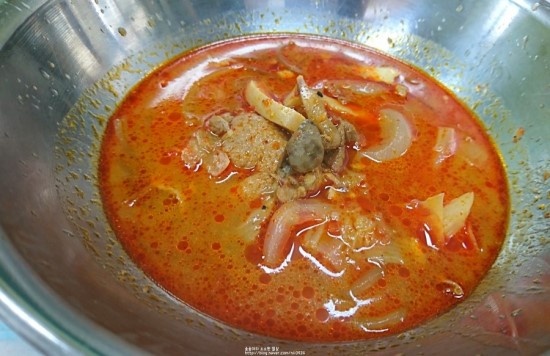Pork Jjamppong (Spicy Noodle Soup)
Golden Recipe for Pork Jjamppong with a Rich and Savory Pork Broth

It’s so cold today! The weather app says it’s -14 degrees Celsius – unbelievable, right? On such a chilly day, a warm and spicy soup is exactly what you crave. Personally, I’m just having some barley tea right now, haha. Last week, when I made a meal at the office, I decided to prepare the Pork Jjamppong that I often make for my parents. On a day like today, when there are severe weather alerts and it’s this freezing, a steaming bowl of Pork Jjamppong feels just right! I’m excited to share my golden recipe for Pork Jjamppong, featuring a delightful savory pork flavor.
Main Ingredients- 1/2 head of cabbage
- 500g pork shoulder (sliced for stir-fry)
- 3 stalks of green onion
- 3 onions
- 3 king oyster mushrooms
- 1 handful of dried gourds (Hobaekgogi)
- 1 handful of dried shiitake mushrooms (Neutaribuseot)
- 3L rice water (for broth)
Seasoning & Broth Base- 5 Tbsp olive oil
- 4 Tbsp minced garlic
- 5 Tbsp red pepper flakes (gochugaru)
- 1/4 tsp black pepper
- 1 Tbsp fish sauce (anchovy or sand lance)
- 2 kits of beef bone broth concentrate (Sago Gomtang)
- 1/3 tsp salt
- 5 Tbsp olive oil
- 4 Tbsp minced garlic
- 5 Tbsp red pepper flakes (gochugaru)
- 1/4 tsp black pepper
- 1 Tbsp fish sauce (anchovy or sand lance)
- 2 kits of beef bone broth concentrate (Sago Gomtang)
- 1/3 tsp salt
Cooking Instructions
Step 1
First, prepare all the ingredients for your Jjamppong. Chop the cabbage into large pieces and slice the pork into bite-sized portions. Cut the green onions lengthwise and julienne the onions and king oyster mushrooms. Soak the dried gourds and dried shiitake mushrooms in cold water. (Feel free to add zucchini or carrots according to your preference.)

Step 2
Prepare the seasonings and broth base that will give your Jjamppong its rich and deep flavor. Mix the minced garlic, red pepper flakes, black pepper, and salt. Also, have ready the two kits of Beef Bone Broth Concentrate (Sago Gomtang) that will enhance the soup’s richness.

Step 3
Heat a generous amount of olive oil in a large pot. Add the lengthwise-cut green onions and begin to stir-fry over medium-low heat.

Step 4
Once the green onions start to soften slightly, add the minced garlic.

Step 5
Sauté the green onions and garlic together until fragrant, creating a flavorful green onion and garlic oil. This step helps to create a clean, non-greasy broth.

Step 6
Now, add the sliced pork shoulder (the kind used for stir-fry) and cook it.

Step 7
As the pork starts to brown on the outside, sprinkle with black pepper. (If you prefer a stronger aroma, grinding fresh peppercorns will add a more sophisticated flavor.)

Step 8
Once the pork is well-cooked and looks appetizing, prepare to add the next ingredients.

Step 9
Add the julienned onions, king oyster mushrooms, and other prepared vegetables to the pot and stir-fry them together with the pork.

Step 10
Add the red pepper flakes and stir-fry everything together so the vegetables and pork are evenly coated. (If you are not using chili oil, adding the red pepper flakes at this stage and stir-frying will help develop a deep flavor without a raw taste.)

Step 11
Pour in the prepared rice water. Rice water helps to make the broth smoother and more savory.

Step 12
Add the soaked dried gourds and dried shiitake mushrooms. These ingredients will add depth and enhance the flavor of the broth. Also, add the fish sauce for an extra boost of umami.

Step 13
Once the broth comes to a rolling boil, add the large chunks of cabbage and continue to cook. The cabbage will release its natural sweetness and refreshing taste into the soup.

Step 14
Now, season the soup by adding the salt and the remaining two kits of Beef Bone Broth Concentrate (Sago Gomtang). The Sago Gomtang adds a rich, deep flavor that might be difficult to achieve with just pork broth alone.

Step 15
Bring the soup to a vigorous boil again over high heat, allowing all the ingredients to meld together. Your delicious Pork Jjamppong is now ready!

Step 16
(Optional) If you have soaked glass noodles (dangmyeon), you can add them in this final stage for an extra satisfying meal. Adding noodles to the Jjamppong broth makes it heartier and even more delicious. (Adding noodles or swirling in a beaten egg can help mellow the spiciness, resulting in a milder, slightly sweet taste.)

Step 17
Voila! Your golden recipe for Pork Jjamppong, boasting a rich and savory pork flavor, is complete. If you prefer it spicier, add chopped Cheongyang chili peppers while cooking, or serve them on the side for individuals to add as they please. I personally can’t handle too much spice, so I chop fresh Cheongyang peppers and add them to my bowl as needed.

Step 18
The vegetables in Jjamppong are very flexible! You can substitute cabbage with napa cabbage, or add fresh seafood like mussels or clams for an even more luxurious soup. Feel free to use whatever ingredients you have on hand in your refrigerator to create your own unique Jjamppong!




